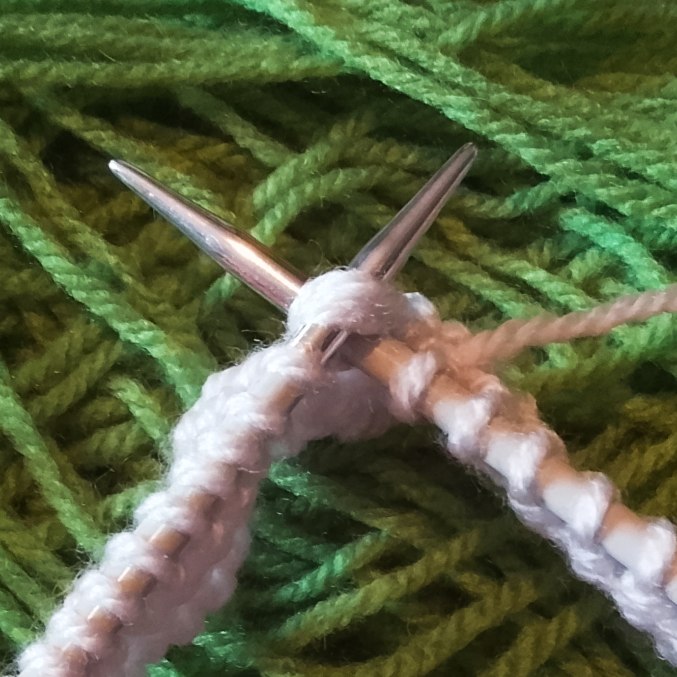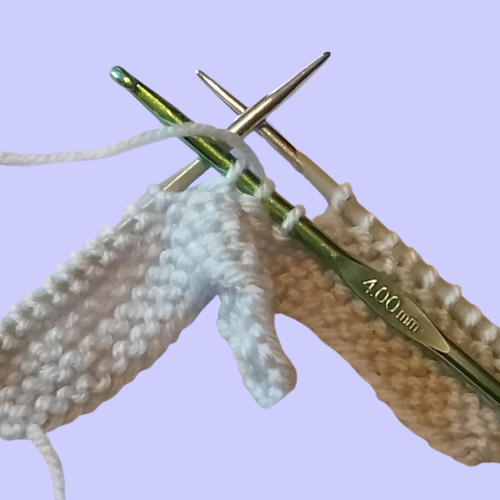Basket
0 items, £ 0.00

In this section...
Mastering K3tog - A Knitter’s Guide to the Knit Three Together Stitch
K3tog demystified. Everything you need to know about K3tog, the powerful triple decrease in knitting. How and why to knit three stitches together with ease.

Close-up of K3tog – three stitches knitted together on the needle. The needle here through the next three stitches ready to knit them together.
What Does K3tog Mean in Knitting?
K3tog stands for knit three stitches together at the same time, resulting in one stitch where there were previously three. This abbreviation follows a simple logic: K4tog, K5tog, and so on all mean knitting that number of stitches together to reduce them to one. These decreases are commonly used in lace knitting, decorative shaping, and structural transitions.
Why Use K3tog Instead of K2tog?
As a designer, I often reach for K3tog when I need a sharper decrease. While K2tog reduces the stitch count by one, K3tog reduces it by two, making it ideal for shaping edges more dramatically or creating defined corners. For example, when working a flat piece, repeating K3tog at the same point across several rows can produce a crisp 90-degree corner. You could achieve a similar effect by knitting two together twice, but this often leaves a visible ladder between stitches; something K3tog avoids.
Creative Uses for K3tog
K3tog isn’t just for corners. It’s brilliant for creating frills and gathers. When repeated across a row, the stitch count drops rapidly, causing the fabric to bunch and form a decorative ruffle. This technique is perfect for cuffs, hems, or anywhere you want a playful flourish.
In lace knitting, K3tog often appears alongside YO (yarn over) or YFWD (yarn forward) to maintain stitch count while adding decorative holes. This pairing creates symmetry and texture, especially in motifs like leaves. In fact, K3tog is frequently used as a centre double decrease in leaf patterns, helping shape both sides of the leaf while forming a central vein.

How to K3tog using a crochet hook is an easy trick and perfect for knitting three together the easier way.
How to Knit K3tog Successfully
Knitting three stitches together can be fiddly, especially with tighter tension or bulkier yarns. Here are some tried-and-tested tips to make it easier:
- Plan ahead: If you know a K3tog is coming, work the previous row a little looser. This gives you more room to manoeuvre.
- Loosen stitches manually: Insert your right-hand needle as if to knit three together, then gently wiggle the needles in a scissor-like motion to loosen the stitches before completing the decrease.
- Use metal needles: Slippery needles reduce resistance, making it easier to slide the yarn through multiple stitches.
- Try a smaller needle: Use a thinner metal needle to perform the K3tog, then transfer the resulting stitch to your working needle.
- Alternative method: Slip one stitch, knit the next two together, then pass the slipped stitch over the K2tog. This also reduces the stitch count by two.
- Crochet hook trick: Insert a hook into the three stitches, yarn over, and pull through to create the new stitch. This can be especially helpful with sticky yarns or tight tension.
Final Thoughts
K3tog is a versatile and elegant decrease that adds both function and flair to your knitting. Whether you’re shaping corners, adding frills, or working intricate lace, mastering this stitch opens up a world of design possibilities. Experiment with different techniques and tools to find what works best for your yarn and project. And remember; every knitter has their own preferences, so don’t be afraid to adapt and explore.
Tags:







